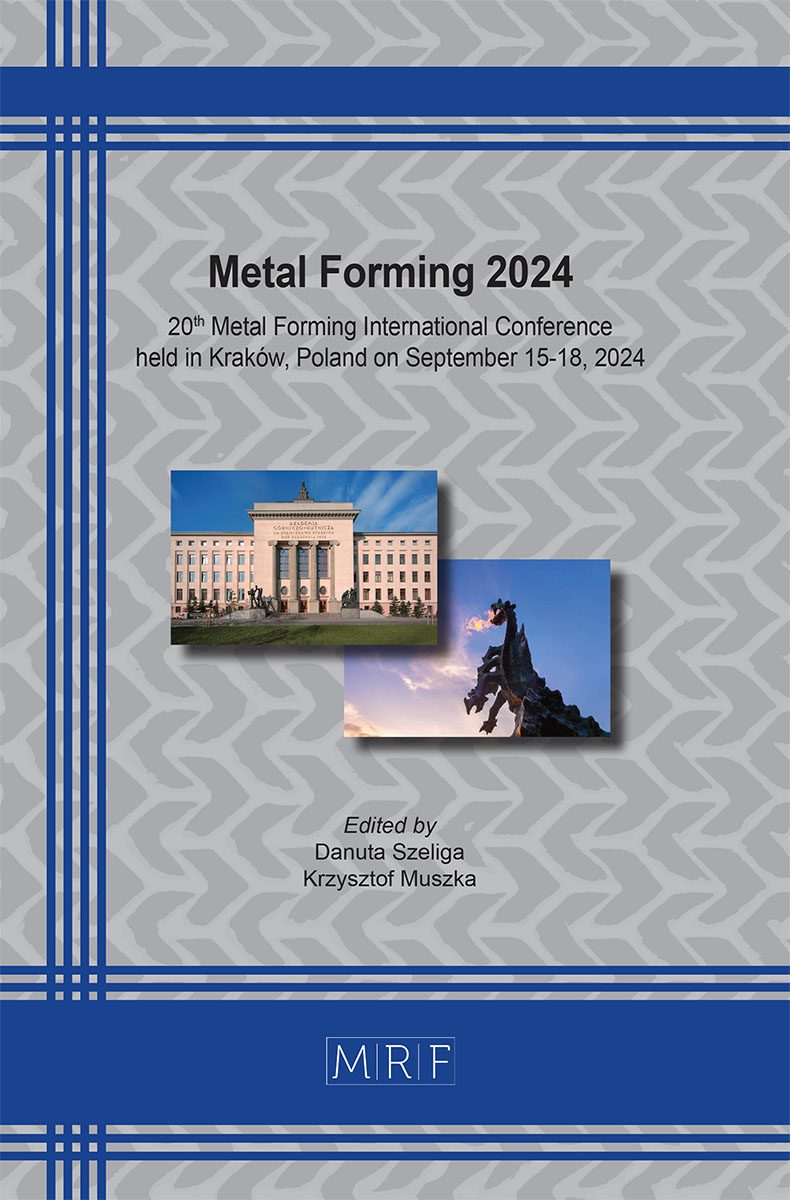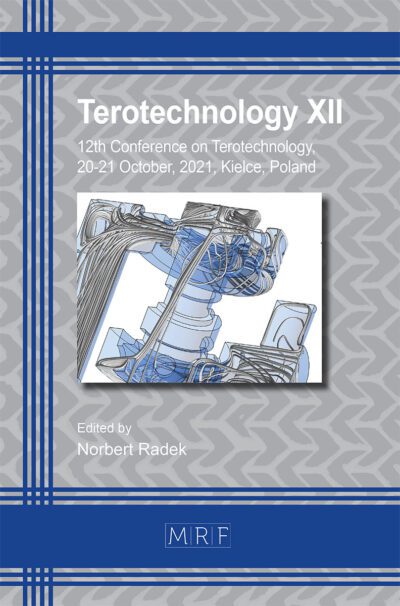–
The role of thermomechanical processing in controlling the microstructure inhomogeneity as a way to create special properties of (FeMnNiCo)1-x Mox high entropy alloy – a practical approach
CICHOCKI Kamil, BAŁA Piotr, HENSCHEL Sebastian, KRÜGER Lutz, MUSZKA Krzysztof
download PDFAbstract. From modern alloys, increasingly demanding combinations of properties are expected, enabling their use as structural materials in new areas of application such as the energy industry (Liquid Natural Gas and hydrogen tanks), military, or space. One of the fundamental expectations for constructional materials used in these sectors is high energy absorption capacity while maintaining high strength (often at low temperatures where e.g. conventional steels exhibit brittleness). Simultaneously, they require appropriate plastic deformation susceptibility (formability) and other additional parameters (e.g., corrosion resistance, weldability, fatigue resistance). Designing manufacturing technologies for the metal forming of structural elements from modern engineering materials for the aforementioned applications requires a holistic approach and understanding of the relationships between process parameters (time, temperature, deformation, strain rate), microstructural phenomena (recovery/strengthening mechanisms, phase transformations, precipitation processes), and resulting properties (strength, ductility, toughness). In this work I will provide a practical example of designing specific properties of (CoNiFeMn)1-xMox high entropy alloys by controlling microstructure development at each stage of the metal forming process. The role of recrystallisation, grain growth, and the precipitation of the phase in controlling grain size – a key parameter defining the susceptibility to twinning/nanotwinning in this alloy at cryogenic temperatures – will be discussed.
Keywords
High Entropy Alloy, Strain Rate Effect, Temperature Effect, Compression Test, Strain Hardening, Microstructure, Twinning
Published online 9/15/2024, 9 pages
Copyright © 2024 by the author(s)
Published under license by Materials Research Forum LLC., Millersville PA, USA
Citation: CICHOCKI Kamil, BAŁA Piotr, HENSCHEL Sebastian, KRÜGER Lutz, MUSZKA Krzysztof, The role of thermomechanical processing in controlling the microstructure inhomogeneity as a way to create special properties of (FeMnNiCo)1-x Mox high entropy alloy – a practical approach, Materials Research Proceedings, Vol. 44, pp 393-401, 2024
DOI: https://doi.org/10.21741/9781644903254-43
The article was published as article 43 of the book Metal Forming 2024
![]() Content from this work may be used under the terms of the Creative Commons Attribution 3.0 license. Any further distribution of this work must maintain attribution to the author(s) and the title of the work, journal citation and DOI.
Content from this work may be used under the terms of the Creative Commons Attribution 3.0 license. Any further distribution of this work must maintain attribution to the author(s) and the title of the work, journal citation and DOI.
References
[1] B. Cantor, I.T.H. Chang, P. Knight, A.J.B. Vincent, Microstructural development in equiatomic multicomponent alloys, Mater. Sci. Eng. A 375-377 (2004) 213-218. https://doi.org/10.1016/j.msea.2003.10.257
[2] D. B. Miracle, High-Entropy Alloys: A Current Evaluation of Founding Ideas and Core Effects and Exploring ‘Nonlinear Alloys, JOM 69 (2017) 2130-2136. https://doi.org/10.1007/s11837-017-2527-z
[3] J.M. Park, J. Moon, J.W. Bae, M.J. Jang, J. Park, S. Lee, H.S. Kim, Strain rate effects of dynamic compressive deformation on mechanical properties and microstructure of CoCrFeMnNi high-entropy alloy, Mater. Sci. Eng. A 719 (2018) 155-163. https://doi.org/10.1016/j.msea.2018.02.031
[4] J. Wang, Y. Liu, B. Liu, Y. Wang, Y. Cao, T. Li, R. Zhou, Flow behaviour and microstructures of powder metallurgical CrFeCoNiMo0.2 high entropy alloy during high temperature deformation, Mater. Sci. Eng. A 689 (2017) 233-242. https://doi.org/10.1016/j.msea.2017.02.064
[5] L. Kaushik, M.-S. Kim, J. Singh, J.-H. Kang, Y.-U. Heo, J.-Y. Suh, S.-H. Choi, Deformation mechanisms and texture evolution in high entropy alloy during cold rolling, Int. J. Plast. 141 (2021) 102989. https://doi.org/10.1016/j.ijplas.2021.102989
[6] K. Cichocki, P. Bała, T. Kozieł, G. Cios, N. Schell, K. Muszka, Effect of Mo on Phase Stability and Properties in FeMnNiCo High-Entropy Alloys, Metall. Mater. Trans. A Phys. Metall. Mater. Sci. 53 (2022) 1749-1760. https://doi.org/10.1007/s11661-022-06629-x
[7] A. Najafizadeh, J.J. Jonas, Predicting the critical stress for initiation of dynamic recrystallization, ISIJ Int. 46 (2006) 1679-1684. https://doi.org/10.2355/isijinternational.46.1679
[8] K. Cichocki, P. Bała, M. Kwiecień, M. Szymula, K. Chrzan, C. Hamilton, The influence of Mo addition on static recrystallization and grain growth behaviour in CoNiFeMn system subjected to prior deformation, Arch. Civ. Mech. Eng. 24 (2024). https://doi.org/10.1007/s43452-024-00888-8
[9] S.A. Sajadi, M.R. Toroghinejad, A. Rezaeian, G.R. Ebrahimi, Dynamic recrystallization behavior of the equiatomic FeCoCrNi high-entropy alloy during high temperature deformation, J. Mater. Res. Technol. 20 (2022) 1093-1109. https://doi.org/10.1016/j.jmrt.2022.07.055
[10] W. Kucza, J. Dąbrowa, G. Cieślak, K. Berent, T. Kulik, M. Danielewski, Studies of ‘sluggish diffusion’ effect in Co-Cr-Fe-Mn-Ni, Co-Cr-Fe-Ni and Co-Fe-Mn-Ni high entropy alloys; determination of tracer diffusivities by combinatorial approach, J. Alloy. Compd. 731 (2018) 920-928. https://doi.org/10.1016/j.jallcom.2017.10.108
[11] K.Y. Tsai, M.H. Tsai, J.W. Yeh, Sluggish diffusion in Co-Cr-Fe-Mn-Ni high-entropy alloys, Acta Mater. 61 (2013) 4887-4897. https://doi.org/10.1016/j.actamat.2013.04.058














